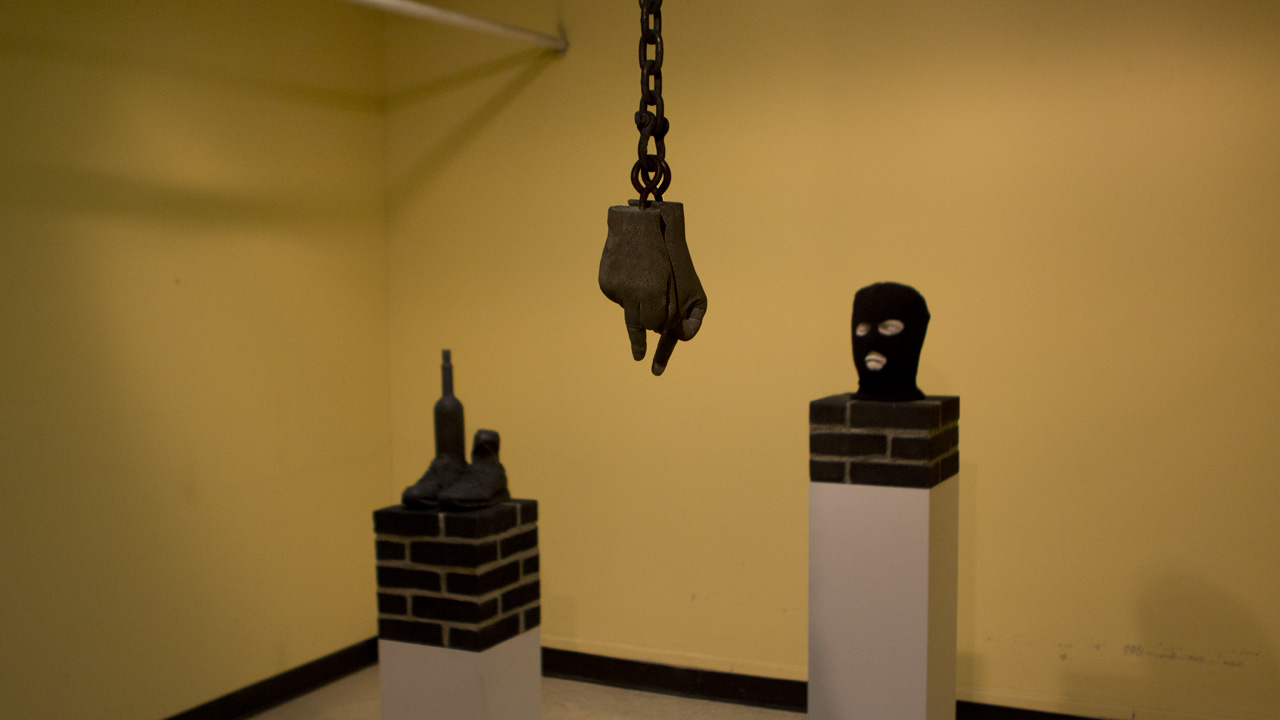Hidden within the sterile, long-abandoned second floor rooms of the Farley Post Office in Midtown, there is a vast and impressive collection of art. Works by Picasso, Warhol, Basquiat, Condo, Manzoni and others — some never before exhibited in public — contrast stunningly against the decrepit walls and outdated decor of the labyrinthine space. Decades ago, there were prison cells and an infirmary. Now, there are Harmony Korine’s VHS and Betty Tompkins’ Fuck Painting #41.
Soon, construction will begin to transform the historic building into Moynihan Station, Manhattan’s future Amtrak hub. Meanwhile, “DSM-V” show organizer Vito Schnabel has filled the space with over two dozen works from his expansive private collection (along with others, courtesy of curator David Rimanelli and various galleries and artists).

The exhibit is named for the latest Diagnostic and Statistical Manual of Mental Disorders — the controversial, so-called “bible” of psychology, whose 5th edition was published just this past weekend. While the new DSM has been criticized for being too culturally-determined, the show’s works raise “questions about the norms of conventional perception and behavior.” Some do this directly, like the Bruce High Quality Foundation‘s installation Psyche Revived, a figurative sculpture paired with a droning male voice listing off mental disorders, while others, like Manzoni’s permanently sealed letter, are psychologically evocative in a more uncanny way. Set against the stifling, institutional backdrop of Farley’s 2nd floor, one can’t help but think of all the artistic legends who have historically been locked up in asylums for deviating from the “normal.”
“In our era, when naming often suggests a promise of recovery, a prescription covered by insurance, or, for the amateur, a chance to self-diagnose from a tantalizing list that includes mood, anxiety, factitious, dissociative, impulse-control, identity, sexual and gender, and adjustment disorders, the publication of the DSM-V, following 13 years of intense debate, has powerful implications,” the press release contextualizes.

With such revisions as changing “gender identity disorder” to the slightly-less-stigmatizing “gender dysphoria,” and a less one-size-fits-all approach to disorders like depression and autism (which are now diagnosed on a severity spectrum), the implications are certainly powerful.
The addition of TV’s beloved hoarding as a disorder, for instance, is testament to how popular culture affects how we view mental health. The DSM, which dogmatically rules over the healthcare industry and the identities of so many patients, is simultaneously based on, and defining of our social norms. Which, of course, brings us back to that age-old bond between art, social conventions, insanity, and the self.
 “No one can fail to encounter a few familiar reflections in the exhaustive pages of the DSM, the fantasy of inclusion, ‘is that me they’re talking about?,’ hovers over the exhibition, collapsing the distance between audience and artwork.”
“No one can fail to encounter a few familiar reflections in the exhaustive pages of the DSM, the fantasy of inclusion, ‘is that me they’re talking about?,’ hovers over the exhibition, collapsing the distance between audience and artwork.”
“From Daniel Buren’s awning stripes, to Rashid Johnson’s black soap, Jade Berreau and Dash Snow’s undergarments, and Nancy Barton’s human remains, no material in DSM-V remains neutral, least of all, the exhibition site itself.”

This is a unique opportunity to see some amazing (free) art in a very bizarre setting. Don’t be discouraged by the postal workers who shoot you annoyed leers when you ask for directions, or the long, dark stairwell leading to the space, or the dingy sign at the show’s entrance that reads “AREA CLOSED — NO TRESSPASSING,” or even the sweaty, wild-eyed man who suddenly appears behind you and says, “Oh, there’s art? I thought this was, like, a health seminar.” Yes, that happened.
“DSM-V,” Various Artists, May 8- June 4, The Future Moynihan Station, Midtown (Photos: Julia Dawidowicz/ANIMALNewYork)



